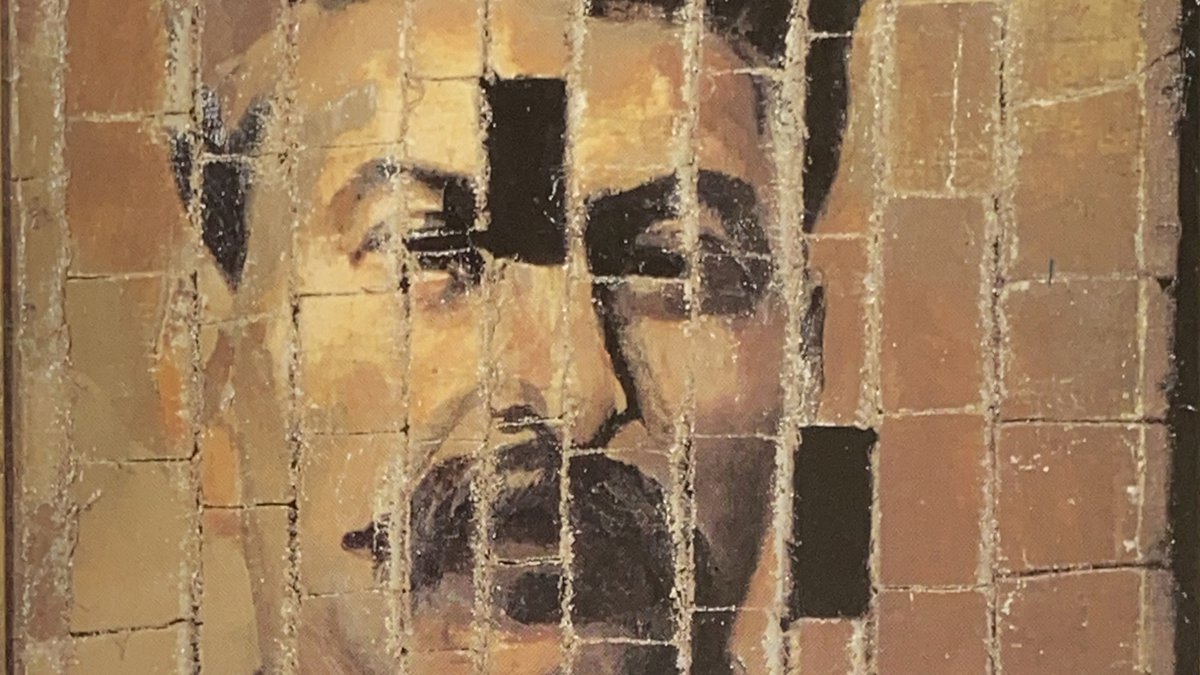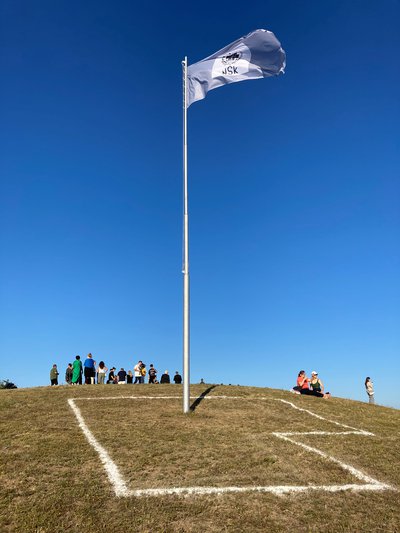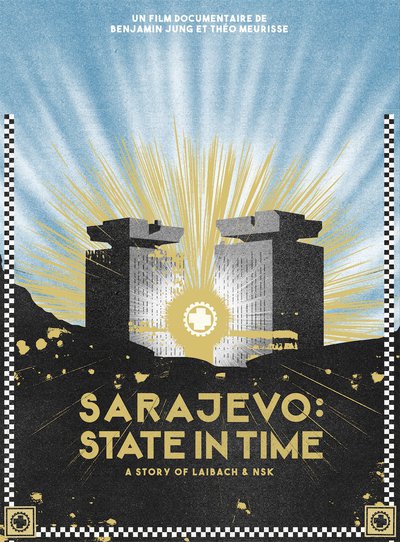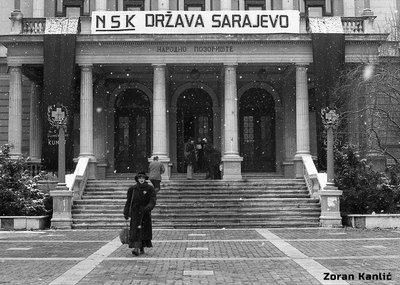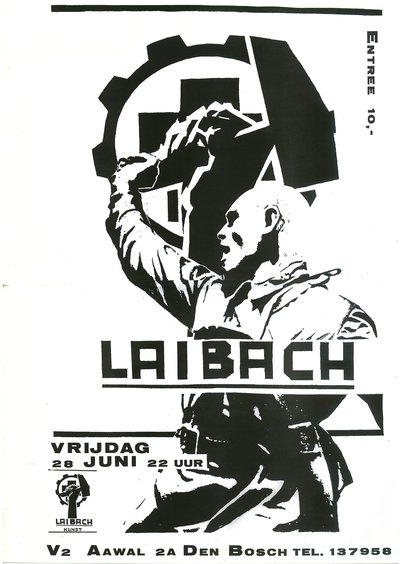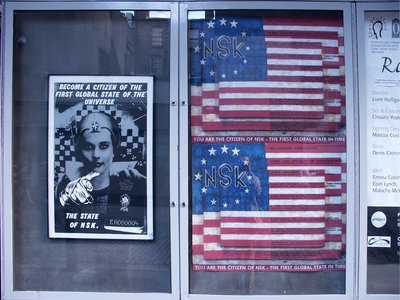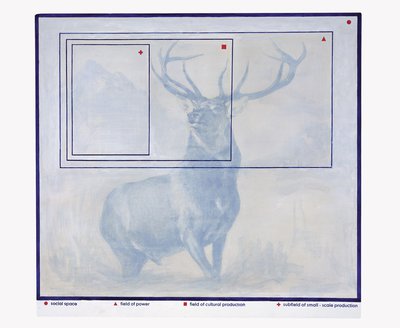XY Unsolved
Churchill once famously described Russia as "a riddle wrapped inside a mystery wrapped inside an enigma". In the Western political and cultural imagination (or fantasy space), this attitude to "Russia" stands in for "the East" generally, and for all that from a Western perspective is archaic, obscure, or perverse. Churchill's description could equally be applied to NSK, and particularly to Laibach, as an equally fascinating and frustrating presence within the Western popular imagination.
Few in the West are aware of differences between for instance Slovene and Polish culture, and even now that Slav states are in the EU, Slavic cultures are still sometimes seen as a uniformly crisis-stricken zone of obscurity and darkness. Slav languages add to the impression of impenetrability and are both a screen behind which Slavs can maintain mystery and a source of apprehensive fascination in the West. Even with the international success and recognition of NSK and some Russian, Yugoslav and other artists and filmmakers, Slav cultures retain a mysterious, exotic aura. The histories and symbols of the region are far less “transparent”, less exhaustively known and documented than those of the West. This both makes it more difficult for so-called “Eastern” artists to move West and presents a rapidly vanishing opportunity to retain more mystery and ambiguity than is possible in the “West.” To some extent then, NSK appears enigmatic simply because of its origins, which it amplifies rather than downplays. This quality has been ruthlessly exploited by NSK in its conquest of the West.
This will become clearer if we return to Churchill and his (ab)use by Laibach. Churchill's wartime ally Tito was of course also used by Laibach and other NSK sections and their use of both illustrates the series of British-Yugoslav connections apparent in Laibach's work. Churchill's symbolic presence in British culture is very similar to the shadow cast by Tito in post-war Yugoslavia. Although Tito died only in 1980, he was rapidly subject to popular-cultural “sampling” as typified by Laibach, much of it ironic and aggressive. In contrast although Churchill died as long ago as 1965 his posthumous career has been far more tranquil. Apart from historical re-assessments that draw attention to his unpleasant attitudes to other races and cultures (for instance his support for the use of Gas against the Kurds in the 1920s) it's very hard to find any British equivalents to the abuse of Tito's image and it seems to remain an unspoken taboo to question or attack Churchill.
The final track of Laibach's Opus Dei (1987) appropriated Churchil's famous “We shall fight them on the beaches” speech. On it's release, Opus Dei was criticised by some as being more simplistic and accessible than its predecessors, but this overlooked both Laibach's ambition to penetrate pop culture and the fact that it is a multi-dimensional work. Churchill's conscription into “the universe of LAIBACH-KUNST machine” illustrates this. Churchill's presence makes it much harder to maintain that this is some sort of Nazi provocation. The reading of the speech is solemn and dignified, true to the stirring tone of the original, which made it such effective wartime propaganda. If Churchill were under overt attack, or was being assimilated into a neo-Nazi perspective this would not be the speech to choose. A more appropriate Churchill quotation would be:
"I will not pretend that, if I had to choose between communism and nazism, I would choose communism." 1
Churchill's presence adds to Laibach's heroic facade, but is neither critical nor uncritical. Like Tito, Churchill was a deeply ambivalent figure, associated both with the defeat of Nazism, but also with the ruthlessness that helped bring victory. On Opus Dei, Churchill sits alongside pro-Fascist poet Ezra Pound (the source of the verse read on the track F.I.A.T.) plus of course Freddie Mercury, author of One Vision, re-presented by Laibach as Geburt Einer Nation and Slovene national poet France Preseren, whose Zdravljica is the basis of How The West Was Won. Opus Dei's most provocative element is the image that appears on the inner sleeve, the axe-swastika that nearly prevented the album being released in West Germany.
For it's critics, this is the “smoking gun” that proves Laibach's guilt once and for all. Despite the improbability of such a contradictory range of sources representing a literal political movement, the image seems to prove beyond any doubt what Laibach are really supposed to be. Except the album wasn't banned for use of the swastika because the image is of course by the noted anti-fascist photo-montagist, John Heartfield, and was an attempt to symbolise what the swastika ultimately promised.
Opus Dei then, is a very dramatic though certainly not unique example of Laibach and the shadowy NSK structure behind it as a Churchillian “riddle wrapped inside a mystery wrapped inside an enigma”. The conceptual energy produced by an observer trying to de-code these contradictions is used to re-code the phenomenon into what the observer desires it to be. So we have a dual movement of de-coding and re-coding, incited by a dual process active in NSK of simultaneous cultural decryption and encryption. NSK both construct and illuminate mystery and uncertainty, and this construction of mystery illuminates “the relationship between art and ideology” that illuminates everything else. The “light” of NSK's operations simultaneously creates enlightenment and obscurity. Opus Dei illustrates both how phenomena are obscured by visibility and made visible by being obscured.
Mystifying Demystification
"Propaganda ceases to work as soon as its presence becomes apparent." Goebbels
Effectively the multi-referentiality of Opus Dei and of NSK generally, represents an encryption of where NSK really stand, but also a decryption of hidden cultural connections and power relations that are normally kept concealed and obscured. NSK interrogate regimes by rendering audible/visible a series of connections that "common sense" ideology has to keep concealed in order to maintain the ideological self-reproduction of “the system”. So, for instance, Opus Dei presents connections between rock and fascistic mobilisation in the case of Queen, or the links between pro and anti-Nazi propaganda. This is the sense in which NSK's work is illuminating and destabilising to the "given" order of things. No system can continue to generate or maintain mystique at full efficiency with its codes exposed. The first, decryption, stage of this process represents what Douglas Kahn has described as "Interpolating significance from a field of noise ." 2 As the quantity, intensity and frequency of information exposure increases, so to does social passivity, a condition exposed and tested by NSK interventions. Contemporary society and culture form an informational maelstrom loud enough to effectively encrypt the significant elements of the field. (Consider why the volume used in cinemas has now been increased to levels dangerous to hearing (120db), or why it's now so hard to find public spaces without music, TV, or radio playing.) In this respect, volume is in inverse proportion to comprehension and autonomous critical perception. Just as cultural codes are concealed in this silencing noise, encrypted military communications are hidden in a sea of “white noise,” and are only decipherable by recipients equipped with the codes to re-create meaning from chaos.
Twenty years ago, members of Laibach and NSK perceived themselves as confronted by an institutionalised ideological cacophony produced by the interplay of various socialist theories and Western political and cultural ideas within Yugoslavia. Rather than assume a dissident position of victimhood, NSK developed a cultural decryption apparatus that could decode the messages hidden within generalised noise. Using elements of the political and cultural environment as “ready-mades,” they executed a type of ideological sampling that amplified or “rendered audible” the hidden codes and internal contradictions of a series of artistic, musical, political, linguistic and historical regimes. To explore these repressive agencies it is necessary not just to understand but to plausibly reproduce/implement the system under interrogation. NSK interrogations work when they are most dangerously credible – when they seem to embody or re-transmit the absolute lethality or threat of the decoded regime archetypes (a process that has covert as well as overt modes).
Regimes generate their own alienating noise and it is this as much as it's secrets that have to be masked by background noise. The essence or archetypes of a system are necessarily traumatic when revealed – to all but a few the raw sound of data/fax transmissions or program code is unpleasant and even alienating. These fundamental structural elements are not by nature "user friendly". Users generally do not need, or are not supposed to be, exposed to them; they are by and for the system. Therefore even the simple revelation of the archetypal level (let alone it's active manipulation and combination with other, contradictory elements is traumatic, transgressive and spectacular. Laibach's quasi-totalitarian stage performances in particular and the NSK “project” as a whole represent "an interrogation of interrogation", in other words, of all hegemonic political and intellectual power mechanisms as such, and the (threat of) physical and ideological violence underlying every system.
Laibach's metaphorical decoding and recoding continued the obscure but long-established relationship between rock and military technology highlighted by Friedrich Kittler. Kittler reveals that the legendary "secret messages" on Beatles albums were recorded using tape machines originally developed for military decoding 3. So even before they covered Laibach, the Beatles had introduced the military element into rock. Ever since then, fanatical fans and right-wing anti-rock ideologues have frantically tried to decode the “real” messages supposedly “hidden” on albums. This process is potentially limitless, since any vocal played backwards or slowed down is likely to reveal some sort of phonetic resemblance, whether or not it's creators were aware of it. NSK exploit this suspicion or desire that there must be some other final solution to the enigma, something “behind the scenes” that will make sense of the whole. A related audio-paranoiac belief is EVP, Electronic Voice Phenomena; the mysterious voices that can be detected in white noise or blank recordings. Some claim these are real messages from the dead (including historical figures such as Churchill) others claim they are a diversion designed to obscure larger, more worldly secrets. If the metaphorical and literal voices and messages NSK detect within the noise of ideology and culture were not really there, their work would not produce such strong reactions. The reactions are the symptoms of these spectral presences.
Laibach's work has generated a still-spreading web of rumour, myth, accusation and confusion; background “noise” that produces interference over all wavelengths of cultural and ideological reproduction, "from X-rays to radio waves." 4 The noises it simultaneously reveals and generates represent the ambivalent, morphing nature of the NSK “virus”. This morphing quality makes it far harder to combat because of the difficulty in definitively identifying or re-coding it. By incorporating systemic archetypes and source codes, NSK confuse and frustrate the “IFF” (identify friend or foe) type mechanisms that media and cultural gatekeepers rely on. Their interventions trigger systemic auto immune responses, which further reveal political and cultural mechanisms. 5
The NSK approach is not simply deconstructionist. Having deciphered normally concealed codes they then encode reality to reveal the encoding of reality and the media-technological mystification that supports this. The paradox is that Laibach allow illusory direct access to the real of regimes via encryption. Direct access is facilitated by the recoding of ideology, militarism, religion and capitalism. This recoding takes the form and the tools used by regimes to encrypt their secrets to make these apparent and simultaneously, to cloak and conceal NSK itself. Taking an obscure Slovene historical reference or a Nazi-Kunst painting, NSK introduce their repressed codes, cloaking themselves in the mysteries they reveal. Even more random, inexplicable lyrics or motifs in an NSK work are always there for a reason, even if only to point to a "reason" that isn't there (except in the audience projection) or to add poetic mystique. Every detail is a part of the ultimate effect.
NSK works embody a type of “mystifying demystification” executed via a type of “constructive deconstruction” that has built an ambivalent space from which to view the world.
Mystifying Demystification=Decryption+Recryption (Decoding and Recoding)
The effect of this simultaneous operation is equally paradoxical, the essence of the subject under interrogation becomes both more and less accessible. At the same time as presenting the ultimate absolute embodiment of a regime they are presenting its opposites and in the process symbolically removing or abstracting it. NSK manifest shadowy regime-spectres and traces. Embracing these means embracing their simultaneously present opposites and so no total/final engagement is possible with any reality “behind” the phenomenon. To quote Zizek:
"The Real is thus simultaneously the Thing to which direct access is not possible and the obstacle that prevents this direct access; the Thing that eludes our grasp and the distorting screen that makes us miss the Thing." 6
Isn't it obvious?
However, these are esoteric processes and far from apparent to everyone. NSK's simulation of what it interrogates is necessarily so dangerously credible that “it” really does seem to be obvious, to leave no room for any doubt. Reactions generated by Laibach index both repression and apathy. The June 1983 TV interview action was framed to confirm the mainstream media's claims that Laibach and the rest of the Slovene alternative scene were actually Fascistic. The sight of Laibach on TV, together with its extreme statements provoked a media storm, driving the group underground and provoking the four-year ban on Laibach appearances in Ljubljana. All the evidence necessary to condemn was present, except… Laibach's “fascistic” statements actually sampled self-management texts, their uniforms were Yugoslav army fatigues, and so on. All the elements used to prove the group's guilt also “prove” their innocence. This is the paradoxical position from which Laibach respond to the “eternal question” about if they are really fascist:
"Isn't it evident?"
The element of doubt and uncertainty this introduces into the minds of both opponents and supporters illustrates how the apparent clarity of the group's position is actually an encryption of it, and how the cryptic, concealed elements are actually those that clarify. Mystifying demystification reverses the signals and uses what it interrogates to construct its own mystique. The resulting uncertainty about what Laibach/NSK “really” are, or “really” want, is produced by a paradoxical mechanism. When Laibach seemed to leave no room whatsoever for doubt about their intentions, their apparently monolithic appearance was actually the result of other incongruous and paradoxical elements. Laibach seemed Fascistic whilst simultaneously quoting pop art, socialist ideology, Mick Jagger or Slavic folklore. At times one of the elements will predominate, but the others are always present, and in a sense it is the contradictory elements that guarantee the apparent consistency of the whole, the integrity of the dangerous illusion that sows doubt and confusion. Laibach could only appear to be the absolute embodiment of what many people wanted it to be because of these elements. Even at it's most monolithic, the process remains plural and in motion.
Similarly, all NSK works function by manipulating paradox and neither assimilating nor resolving their contradictory sources. NSK texts intensify this effect, raising questions even as they seem to answer them. The cumulative effect is a machine of expression that interrogates the onlooker as well as the sources of the works, placing on them the responsibility to process the contradictions generated by the works. Simultaneously, NSK interrogate their sources and their inter-relations, raising questions of censorship, artistic value, the nature of national identity, historical memory, past and future realities. Over time the NSK Interrogation Machine has mutated and proliferated to bring everything into its scope.
Each NSK intervention adds to the body of mythology and rumour, generating further noise and making it more difficult to identify “true” intentions and producing more disputes about what they really stand for. The fundamental symbolic meaning of a system is thrown into question, to the extent that its "true" meaning becomes open to dispute. This is a type of dialectical process that generates endless debate about whether the “hidden reverse” of a system (as opposed to its user-friendly public interface) is not actually its "true" face. 7 This is an example of the process whereby NSK interrogations activate a series of associations and discourses that are difficult to contain once set in motion, and which leave an irreversible shadow on their subjects.
According to the concept of over-identification, NSK's totalitarian image could be seen as too totalitarian for the totalitarians. Ultimately, Laibach's conceptual uber-fascism is actually too fascistic for the fascists. The group is free to be absolutist, whereas actual contemporary Fascist projects have to calm, seduce and pacify as much as agitate. Rather than Laibach's being a “purely” aesthetic fascism with the distasteful, unhealthy elements removed – "diet fascism" it works as a hyper-fascism that is simultaneously a hyper-Slavism, hyper-conceptualism, hyper-anarchism etc. Laibach's is a high-calorie, unhygienic, cholesterol-rich “meal”, completely at odds with the friendly blue-jeans wearing image of Haider or Berlusconi.
Where the group really stand “should” be clear but isn't (or is it?). Here again Tito, one of NSK's primary sources is relevant. For the 1985 track Panorama Laibach appropriated a 1958 speech by Tito in defence of Yugoslavia's non-aligned foreign policy:
"It should be clear to everyone that we are not nobody's appendages of nobody's politics." Tito/Laibach
Non-alignment was a means of preserving autonomy and freedom of manoeuvre and its metaphorical use by NSK functions similarly. NSK contains traces that seem to prove where it really “belongs” but remains in its own space. Yugoslav policy was openly fluid and flexible in supposed contrast to the inflexible rigidity of Stalinist policy. Yet in practice, Stalin's regime was highly ambiguous and authors such as Mikhail Epstein and Tuomas Nevanlinna have remarked on its eclectic, or even postmodern qualities. What Zizek calls the "Stalinist semiotic space" 8 was not one of simple commands and responses. Shifts in policy were often signalled in a highly cryptic esoteric fashion, via anonymous letters or historical footnotes, which even the nomenklatura could not always be sure they had correctly interpreted. The "real" command often contradicted the official, public message, and it was the “hidden reverse” of the type NSK bring to light that was to be implemented. Here again, what seemed oblique was sometimes obvious and what seemed obvious could be oblique or irrelevant. Since nothing was ever explicitly spelt out, officials were caught between excessive leniency and overzealousness in implementing policy, never entirely sure what was correct and what might change at any moment. Similarly, by incorporating the Stalinist (ambiguous and authoritarian) tendencies of the state, Laibach left it suspended in a similar state of doubt about what policy would be correct (cultural tolerance or populist censorship). The difference is that Laibach was linked to an abstract not an actual apparatus. NSK's stance mirrors both the non-alignment of Yugoslav policy and the total ambiguity of Stalinist policy. Like conceptual art, the fatal ambiguity of Stalinism is never “really, finally” resolved because the official and the citizen alike are never really sure if their interpretation is correct, and don't want to face the terrifying possibility that there is no correct interpretation.
Stalin features in Irwin's 1988 image “Basics of Morphology” and naturally his presence is unclear – has his image been uncovered or is it being concealed? In effect it is undergoing both in a paradoxical double movement, mystifying demystification. As so often with NSK, the source of the image has its own story. The image was re-assembled from fragments of a discarded painting by painter and theoretician Zoran Didek who produced Socialist Realist works after the war but is also supposed to have been the designer of the Ustasa's notorious “U” symbol.
The NSK strategy is particularly oriented towards rendering visible/audible/ perceptible what Zizek9terms the "obscene underside" of systems and regimes. These are the irrational or disturbing qualities that contradict the public face of a system, and if brought to the surface impede its functioning and perpetuation. Unauthorised, spontaneous connectivity is always potentially transgressive and de-stabilising, producing the re-channelling energies and exposing secret links and pathways. By restoring repressed qualities, NSK create a type of parasitic attachment that interrogates both the system and the hidden absolutes that consciously or unconsciously structure it, setting into motion their contradictions and disrputing their operation.
However, if NSK's works were purely conceptual or cryptic, they would not have the same impact. Irwin's multi-layered, multi-temporal paintings and installations are effectively viral artefacts - artefacts as temporal viruses containing embedded disruptive codes. The viral (active) elements are the traumatic and spectacular archetypes used to generate dissonant conceptual energy. 10 The paintings and objects simultaneously bring forward supposedly defunct symbols (totalitarian or national motifs) and drag back supposedly contemporary, modern elements (pop art, contemporary design or packaging). Yet while they do contain this concentrated conceptual energy and are the expression of complex methodologies, for many they do function autonomously as aesthetic objects that inspire and seduce as much as they mystify. The encoding/decoding mechanisms discussed here are present in the fabric of these works but the final results are very much more than the sum of these contradictory parts. The NSK State represents some sort of final “answer”, to the questions NSK have raised, but we should cherish the unsolved or ultimately unsolvable elements of NSK, even as we attempt to decode them.
